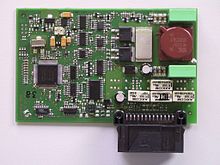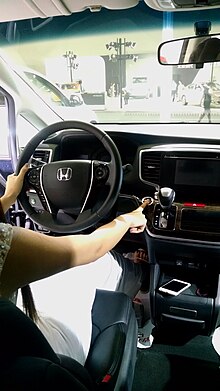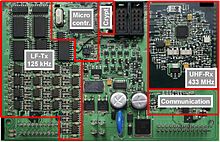
Motor vehicle theft or car theft is the criminal act of stealing or attempting to steal a motor vehicle.

A car alarm is an electronic device installed in a vehicle in an attempt to discourage theft of the vehicle itself, its contents, or both. Car alarms work by emitting high-volume sound when the conditions necessary for triggering it are met. Such alarms may also cause the vehicle's headlights to flash, may notify the car's owner of the incident via a paging system, and may interrupt one or more electrical circuits necessary for the car to start. Although inexpensive to acquire and install, the effectiveness of such devices in deterring vehicle burglary or theft when their only effect is to emit sound appears to be negligible.

Power door locks allow the driver or front passenger to simultaneously lock or unlock all the doors of an automobile or truck, by pressing a button or flipping a switch.
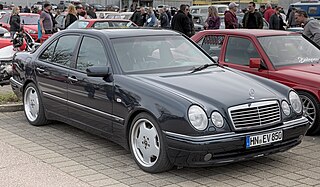
The Mercedes-Benz W210 is the internal designation for a range of executive cars manufactured by Mercedes-Benz and marketed under the E-Class model name in both sedan/saloon (1995–2002) and station wagon/estate (1996–2003) configurations. W210 development started in 1988, three years after the W124's introduction.

The second generation of the CL-Class used the C215-chassis designation and was manufactured and marketed by German automaker Mercedes from 1998–2006 as the company's flagship model, a two-door, four-passenger coupé.

The Mercedes-Benz W221 is a chassis code of the fifth generation S-Class, produced from August 2005 until June 2013. The W221 S-Class was unveiled at the 2005 Frankfurt Motor Show as the successor of the Mercedes-Benz S-Class (W220) and the predecessor of the Mercedes-Benz S-Class (W222).
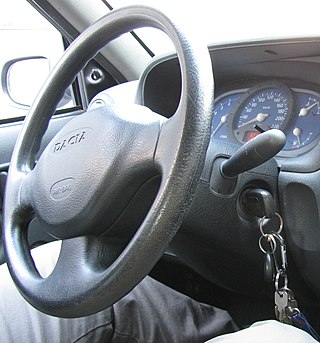
A car key or an automobile key is a key used to open and/or start an automobile. Modern key designs are usually symmetrical, and some use grooves on both sides, rather than a cut edge, to actuate the lock. It has multiple uses for the automobile with which it was sold. A car key can open the doors, as well as start the ignition, open the glove compartment and also open the trunk (boot) of the car. Some cars come with an additional key known as a valet key that starts the ignition and opens the driver's side door, but prevents the valet from gaining access to valuables that are located in the trunk or the glove box. Some valet keys, particularly those to high-performance vehicles, go so far as to restrict the engine's power output to prevent joyriding. Recently, features such as coded immobilizers have been implemented in newer vehicles. More sophisticated systems make ignition dependent on electronic devices, rather than the mechanical keyswitch. A number of these systems, such as KeeLoq and Megamos Crypto have been demonstrated to be weak and vulnerable to cryptanalytic attacks.

A remote keyless system (RKS), also known as remote keyless entry (RKE) or remote central locking, is an electronic lock that controls access to a building or vehicle by using an electronic remote control. RKS largely and quickly superseded keyless entry, a budding technology that restrictively bound locking and unlocking functions to vehicle-mounted keypads.
A rolling code is used in keyless entry systems to prevent a simple form of replay attack, where an eavesdropper records the transmission and replays it at a later time to cause the receiver to 'unlock'. Such systems are typical in garage door openers and keyless car entry systems.

An immobiliser or immobilizer is an electronic security device fitted to a motor vehicle that prevents the engine from being started unless the correct key is present. This prevents the vehicle from being "hot wired" after entry has been achieved and thus reduces motor vehicle theft. Research shows that the uniform application of immobilisers reduced the rate of car theft by 40%.

An ignition switch, starter switch or start switch is a switch in the control system of a motor vehicle that activates the main electrical systems for the vehicle, including "accessories". In vehicles powered by internal combustion engines, the switch provides power to the starter solenoid and the ignition system components, and is frequently combined with the starter switch which activates the starter motor.
KeeLoq is a proprietary hardware-dedicated block cipher that uses a non-linear feedback shift register (NLFSR). The uni-directional command transfer protocol was designed by Frederick Bruwer of Nanoteq (Pty) Ltd., the cryptographic algorithm was created by Gideon Kuhn at the University of Pretoria, and the silicon implementation was by Willem Smit at Nanoteq (Pty) Ltd in the mid-1980s. KeeLoq was sold to Microchip Technology Inc in 1995 for $10 million. It is used in 'hopping code' encoders and decoders such as NTQ105/106/115/125D/129D, HCS101/2XX/3XX/4XX/5XX and MCS31X2. KeeLoq has been used in many remote keyless entry systems by such companies like Chrysler, Daewoo, Fiat, Ford, GM, Honda, Mercedes-Benz, Toyota, Volvo, Volkswagen Group, Clifford, Shurlok, and Jaguar.
An anti-hijack system is an electronic system fitted to motor vehicles to deter criminals from hijacking them. Although these types of systems are becoming more common on newer cars, they have not caused a decrease in insurance premiums as they are not as widely known as other more common anti-theft systems such as alarms or steering locks. It can also be a part of an alarm or immobiliser system. An approved anti-hijacking system will achieve a safe, quick shutdown of the vehicle it is attached to. There are also mechanical anti-hijack devices.

The second-generation Subaru Legacy was marketed in Japan from October 1993, and July 1994 marked the second generation in North America with a full body and chassis revision. The exterior was designed by Olivier Boulay in 1991, during his tenure at Subaru. The tail light appearance on both the sedan and wagon was influenced by the taillights on the SVX.

A smart lock is an electromechanical lock that is designed to perform locking and unlocking operations on a door when it receives a prompt via an electronic keypad, biometric sensor, access card, Bluetooth, or Wi-FI from a registered mobile device. These locks are called smart locks because they use advanced technology and Internet communication to enable easier access for users and enhanced security from intruders. The main components of the smart lock include the physical lock, the key, a secure Bluetooth or Wi-Fi connection, and a management mobile app. Smart locks may also monitor access and send alerts in response to the different events it monitors, as well as other critical events related to the status of the device. Smart locks can be considered part of a smart home.

The Mercedes-AMG GT is a series of 2-door sports cars produced by German automobile manufacturer Mercedes-AMG. The car was introduced on 9 September 2014 and was officially unveiled to the public in October 2014 at the Paris Motor Show. While not directly replacing the SLS AMG, it is the second sports car developed entirely in-house by Mercedes-AMG. The Mercedes-AMG GT went on sale in two variants in March 2015, while a GT3 racing variant of the car was introduced in 2015. A high performance variant called the GT R was introduced in 2016. A GT4 racing variant, targeted at semi-professional drivers and based on the GT R variant, was introduced in 2017. In 2021, a new variant called the AMG GT Black Series was released. All variants are assembled at the Mercedes-Benz plant in Sindelfingen, Germany.

Mercedes-Benz W202 is the internal designation for a compact sedan/saloon manufactured and marketed by Mercedes-Benz between 1992 and 2001, as the first generation of the C-Class, now in its fifth generation. Replacing the 190 series/W201 in June 1993, the C-Class sedan was Mercedes' entry-level model until 1997, when the company launched the A-Class. Production reached 1,847,382 over model years 1994–2000.

UniKey Technologies is an alternative access control company based in the United States that designs and licenses keyless entry technology worldwide. Its first product in partnership with Kwikset was Kēvo, a Bluetooth-enabled deadbolt door lock.

The Mercedes-Benz A-Class(W177) is the fourth and current generation of the A-Class range of subcompact executive hatchbacks and sedans. It was launched in 2018 as the successor to the W176 A-Class, with sales commencing in March 2018. The available body styles include:

